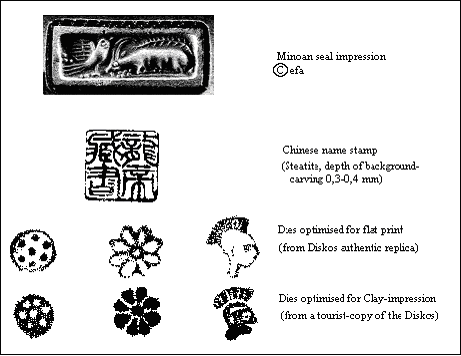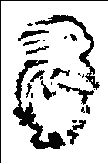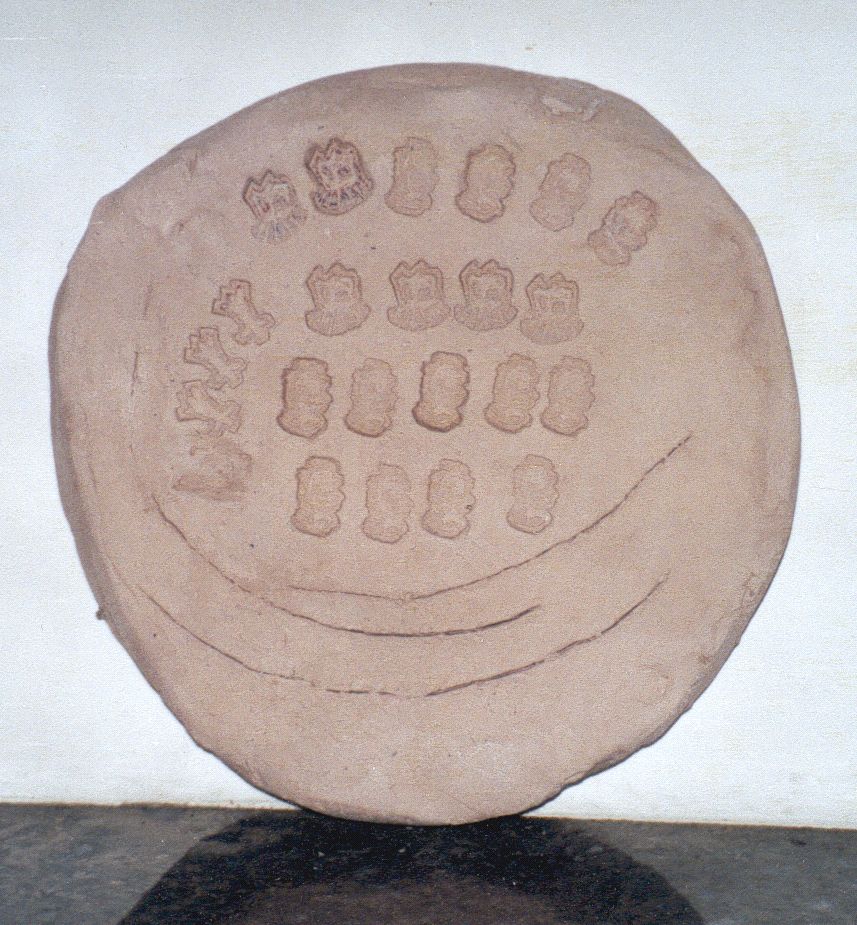 |
Introduction
The Phaistos Disk, a round clay tablet of 15,8-16,5 cm diameter, was found in the year 1908 by Pernier (1909)[1] in the NE remains of the older Minoan palace of Phaistos. Unfortunately, the layers embedding the Disk were found disturbed and seemed to have fallen down from a higher level which was destroyed by fire. Thus, despite the fact that some of the accompanying findings point to MMIIIb (Middle Minoan IIIb=c. 1765 BCE), the production date as well as the geographical origin of the Disk have been under discussion in wide frames for a hundred years now. Most comprehensively this history is reported in Neumann (1968)[2], Duhoux (1977)[3], Trauth (1990)[4] and Balistier (1998)[5]. Maybe, a new object found at Vladikavkas (Ossetia), reported by Kouznetsov (2001)[6] will give new fervour to such endeavours.
The high interest in the Phaistos Disk stems from the fact that, on both faces, it contains a spiral bearing characters that obviously form a continuous text. The characters are pictographic and are impressed with punches into the clay-surface Ė thus creating the, by far, earliest example of a text printed with movable types. The text is composed of 45 types (plus a hand-drawn "stroke") and comprises 242 tokens which are articulated into 61 compartments containing 2 - 7 tokens each. According to the type of script presumed, these compartments are interpreted as "words" or "sentences". There has only one other specimen of this kind of writing been found, which is a short text on a votive axe from the Arkalochori cave on Crete (Marinatos 1935)[7]; making a Minoan origin of the Disk probable, but not much contributing to its decipherment.
As well as the semantics of its text, also the production process of the Phaistos Disk remains problematic and has found quite a few different explanations. These explanations regard the manufacture and material of the dies or punches applied for imprinting the text, the printing procedure itself, finally the ceramic finishing by drying and baking of the clay disk.
In order to get some insight into possible and reasonable production alternatives, by help of a friend experienced in ceramics[8], the author staged some practical experiments which are reported in the following.
Material and Production of the dies
First, to the question which material the punches were made of, proposals rank from wood (Neumann 1968) to gold (Godart 1995)[9]. The last proposal was sponsored by the clear and partially very delicate structures of the Diskos-characters and the usual Minoan (negative carving) seal technique. So the idea arose, that a negative carving was filled with gold, which in turn was used as a positive punch.
To test the properties of different materials for clay impression, a clay-plate of about 6 cm diameter and 1 cm thickness was produced having a clay-consistency that could just be formed by hand. Into the upper side, marks were impressed (see Fig 1) with "punches" of different materials (Steatite, jasper, wood and gold).
This gave the following results: Steatite did not show any tendency to cling to the clay. This may be due to its slightly "fatty" property. Also dry wood worked fine. Jasper already had a small, and gold a considerable tendency to cling to the clay and thus to impair the imprint at withdrawal.
 |
After this, the plate was left to dry with the lower side lying on a flat surface for 3 days. The dried clay-plate showed --seen from upside-- a slight concave deformation, and the onset of a crack. The latter fact will provide an argument later on.
As for the production technique of the Diskos dies:
- Most of the found Minoan seals, as well as their conserved imprints, show images which are carved into the material of the die (steatite, onyx, jasper, ivory) as negative relief (Olivier 1996)[10]. In order to gain the positive, these dies can only be impressed into soft surfaces, say clay or wax.
- Contrary to this technique, the images of the Diskos-characters are linear: they are surrounded and internally articulated by embossed lines which are lying in a plane, the same way as our common office-stamps (rubber) or the Chinese name-stamps (usually steatite).
- A third technique would be to carve away the surroundings, leaving the figure in positive relief, and then add the internal details in negative. This procedure results in rather blunt and colour-consuming images when applied to flat surfaces, but the dies are simple to produce and they leave rather agreeable images in clay. In fact, tourist-copies of the Diskos often use this technique.
 |
Fig. 2 shows prints rsp. casts of the different types. Comparing the tree techniques one could surmise, that the Diskos dies were primarily not designed for clay impression, but for printing on a flat surface.
Anyhow, as steatite proved to be a good material for clay impression (i.e. least prone to impair the impressions at withdrawal of the punch), the question remained, whether this material could be wrought to accept the delicate forms of the Diskos dies. Therefore, three dies were carved by the author from this material. The result is shown in Fig. 3.
 |
The first experience was that the professional tools for working steatite (~ dentistís drill) were too clumsy to get out the minute structures of Diskos-comparable dies. Instead, the needle of a compass, emery paper and the file at a Swiss army knife worked reasonably well. In this way, about four hours were required to produce a die from a roughly broken steatite chunk. The steatite-punches thus produced had a depth of background carving of about 1 mm, instead of the much shallower measure of 0,2-0,3 mm of the Diskos-dies. Also the embossed lines could not be made as thin as those of the Diskos. This fact may be due to the authorís awkwardness, because these were his firstlings in the art. Also the Chinese name stamp --shown for comparison in Fig. 2-- does much better, despite being wrought from steatite. The solution to this riddle came, when the hardness of the Chinese material was established to be 2.5 Mohs instead of steatite's 1 by definition in the Mohs scale. The Chinese object had been fired!
Thus, we also fired the die of the female figure in Fig. 3, which increased its hardness from 1 to 2.5 Mohs, and indeed the harder material allowed a reworking which could get out much finer lines (see Fig. 4)
 |
Fabrication of the Diskos Body
The Diskos was produced from a high quality clay, and a reasonable assumption is that it was intentionally baked --not casually by the conflagration of the surrounding building as is the case with almost all other Minoan clay objects.
In the preparation of the Diskos text, a soft consistency of the clay is seen necessary to accept the impressions of the dies. How then could such a soft plate be imprinted at the second side without destroying the text of the down-lying first-printed side? This is the main problem discussed in the literature. Proposals rank from more carefully applied shallower impressions at the second side (Godart 1995 --In fact present, but in size almost insignificant), over the separate preparation of one partial disk for each side and later combination (Grumach 1969)[11], to a three-partite production, where a pre-baked tertiary plate was interfered in order to achieve stability (Meerten 1977)[12].
Funnily, no consideration was given to the more critical drying process of the Disk, which has to be achieved before firing and whereby the clay is shrinking by up to 10%. The drying must proceed evenly in order not crack or wrinkle the Disk. The experiment (see Fig. 1) with the small disk dried lying on his back shows this vividly. The Diskos must have been drying upright and as a unity. Is that possible?
The author produced a disk of Diskos-size and thickness from clay, the consistency of which was such that it did not give way under its own weight, but the clay was still formable to a disk with some force. When imprinting the two faces with the steatite-dies of own production, the positive experience was that the impression of the upper face did not impair the characters of the already printed down-lying face. This fact was due to the consistency of the clay and the thickness of the disk (about 2 cm). Test disks with 1 cm and less did indeed show this impairment, which was feared by quite a few authors and gave rise to the complicated Diskos-production theories. But, the negative experience was that clay of the described consistency did not well accept the internal fine structure of the dies.
As for the force and depth of the impression, it was found that despite of the noticeable backpressure of the clay, impressions of any depth could be achieved depending on the time of applied force. Thus, the control of impression-depth is mainly affected by a control of time, at least in clay of this firmer consistency.
The final and successful solution was to moisten and softly rub the disk-surface before printing, in a way that a fine ooze appeared. This ooze will reproduce the minute details. As the characters are imprinted to a depth larger than the ooze layer, also these details are not impaired when turning the disk and imprinting the other side.
After impression, the disk was put on edge, stood there for about a week, dried with only a minimal broadening of the rim at the standpoint and was finally fired successfully.
 |
Conclusion
It is experimentally demonstrated that --given the dies-- the mechanical and ceramic manufacture of the Diskos (contrary to the opinion of some scholars) could have been rather straightforward. A firmer clay quality can achieve stability and protect the imprints of the down lying face. An oozy surface preparation will accept the imprint details.
As for the dies, steatite provides the advantage of working the outer and rough form of a die from the soft material, then fire and working out the finer details to the degree of the Phaistos Disk dies. Even if these dies primarily may not have been designed for clay impression, they nevertheless provide the best chance to pass on the delicate structures to the clay surface.
The technologies applied here were well in the range of a Minoan artisan. So the described steps provide a feasible and reasonable if not the only way to produce the Phaistos Disk.